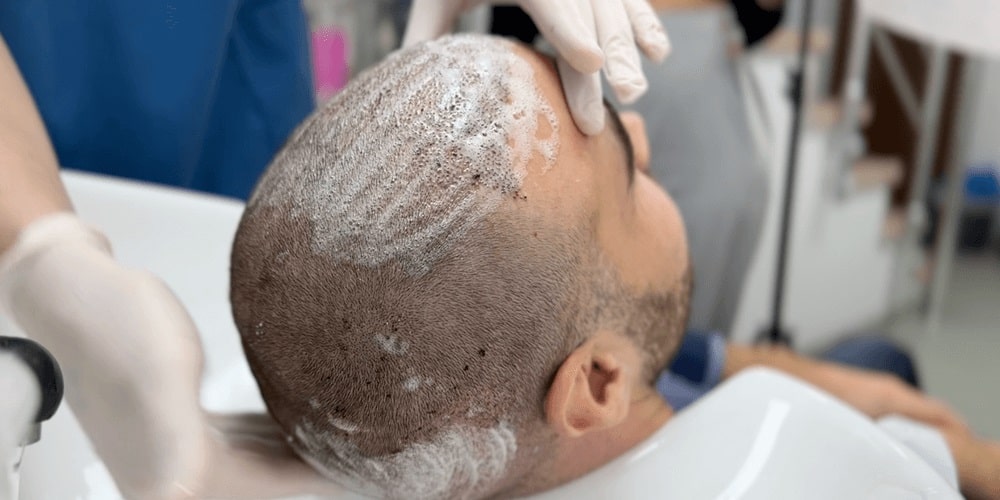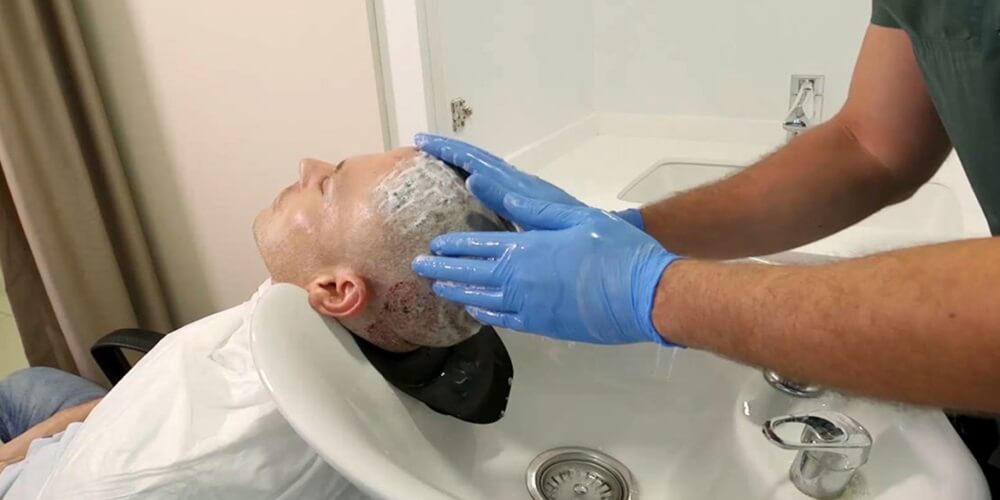Home » Post Hair Transplant Washing Tips

The early days after a hair transplant are important. First and foremost, the hair grafts and the wounds are in the process of initial healing, so aftercare during that period is geared toward making sure the grafts are situated in such a way that they will remain comfortably ensconced in the scalp. Secondly, proper washing during that period is important to maintain overall scalp health. The body’s surface goes through a series of changes as it heals from the initial transplantation. In the incisional area, the skin goes from an open wound to a covered wound, to a covered wound with stitches.
After the stitches are out, the skin has to go from having little holes in it to having fewer and fewer minute holes until it is fully healed at the three-month mark. Although one cannot see these little holes where the sutures were removed, we know that the healing is still underway. Proper hair wash is essential during this healing period if such conditions are to be achieved. In the days of aftercare, the patient is no longer under direct supervision and must integrate it into his daily life, dealing with the idiosyncrasies of everyday things such as water anxiety about causing dislodgement, scalp softness, oiliness, and texture with ongoing improvement and/or shedding, and the devastating effects of seeing transplanted hair with dead skin on their ends. Combine the above points, and we see that a considerable amount of psychological discomfort can be generated in just one day of healing.
Typically, the first hair wash is done on the second day after a hair transplant has been performed, using a shampoo with a balanced pH to preserve the grafts. The temperature of the water should not be too high, and pressure has to be gentle to avoid damaging the grafts or flushing them out of the scalp. Homeopathic lotions containing known irritants should also be avoided as they can cause allergic reactions or delay the inflammatory reaction brought by the patient’s skin healing after a transplant. However,hair wash therapy can provide further benefits for the transplanted follicles and scalp in the days after the transplant. Simply washing the recipient area results in an increased supply of oxygen through the blood’s red cells to the wounded area, which enhances healing.
Hygiene is very important after both hair transplant techniques, mainly because of the FUT. Individuals are usually advised to gently clean off the blood clot that forms on the recipient area after a hair transplant with a saline solution or a commercially prepared option, using a fragrance-free and balanced pH saline solution soaked spray bottle at a pressure higher than the normal flow of saline, but again, not too strong. Failing to do this can lead to the formation of a crust, which is further supported by the scab’s presence post-FUE. However, a gentle cleaning approach is key to avoid damaging the recipient surface and thereby increasing the healing time and the risk of infection. While self-cleansing through irrigation post-FUE is not harmful, over-washing is, and it is not necessary. Moreover, a balance needs to be struck between not under- or over-washing following both procedures, with medical advice providing a guideline on when to hair wash and not engage in recreational activities such as swimming.

First, hair washing after performing a hair transplant should be instituted with the provided instructions by the clinic. Here is an example to better one’s understanding on how to adequately wash hair after the procedure:. Shampooing Process Gather the things that you will be requiring: shampoo-you should use a mild and hypo-allergic kind of shampoo if your skin is sensitive, a cup-it should not have any ridges inside, a sink or a basin, and a hand-held shower head with a spray attachment. Note that it is advisable for you to avoid getting your head wet in the shower for 3-7 days following the procedure. This means you should wash your hair the night before surgery if possible. When you are ready to hair wash, the first thing you want to do is turn the temperature of the water to just a bit warmer than room temperature. This is the best range for minimizing discomfort while removing the shampoo and oil without exacerbating the swelling. Make sure you are in an area that does not have dust, pet dander, or other allergens that might affect you in making an allergic reaction. This is very important because irritation, itching, or an allergic reaction may make you scratch your scalp; this can dislodge a graft. Wet the hair and scalp with the detached shower head so the shower stream is not pointed directly at your head. Keep your head out of the stream when rinsing your hair. Leave some shampoo in the palm of your hand and gently work it over your scalp. You do not need to make big lathers. Gently massage your hair and scalp, but do not scratch. Allow the shampoo to sit on your scalp for approximately one minute. After the application of shampoo, wash off with plenty of water. Direct the sprayer directly at your head when you rinse the shampoo. This will encourage the water to stream over and down your scalp rather than hitting it directly. Move your fingers delicately around your scalp once to make sure you are getting all the soap out of your hair.
Some of the common mistakes that people make when hair transplant after wash are scrubbing too hard, using hair care products that are harsh and detrimental to the scalp, such as those used for dandruff, refusing to wash the hair and the scalp because patients think that it may dislodge their grafts or induce shock loss, exposing the head to pressure under the shower post-operatively, and dunking the head under the water. Keeping the recipient area dirty, i.e., not washing it according to the recommended schedule, and failing to avoid paper towels when drying themselves or their hair can also be harmful. These actions can damage the recipient area and the new grafts and may have a negative consequence on the hair transplant results. For some incorrect post-care practices, such as not washing the hair grafts, it is not possible to quantify the negative outcome that it guarantees. In some cases, it may very well do so. The list below is not exhaustive, so all the actions below must be avoided.
Do not scrub too hard. Often, people do not follow the advice of their clinician and are very aggressive when scrubbing to remove dried scabs and crusts. However, the crusts need to be removed gently, using a specially formulated saline solution and a gentle circular motion with your fingers until they are completely removed. Applying a harsh or inappropriate gel on the recipient region, such as a gel against dandruff, can damage the tissue and expose the hair grafts themselves. The scalp will also be cleaned without subjecting it to additional water pressure. Planting channels start to shut down hair transplant after wash on the second day post hair transplant is complete but can be efficiently sealed within two hours to retain a solid seal and keep fluid and cells. If the hair grafts also start to swim at this monitoring stage, they can be dislodged if they are subject to strong water pressure from a shower, for example.
Developed patients can additionally implement a few advanced strategies into their hair care routines that can further help with the healing process, improve hair restoration results, and jumpstart new hair growth. Complementing the hair transplant after wash hair care routine with treatments or products has the potential to enhance results or alleviate temporary hair loss. Patients should consult their doctor before using supplemental products to ensure they are safe to use and fit their unique needs. Additional treatments or products that contribute to post-hair transplant hair care include:
Some popular recommendations for shampoos and conditioners that aid in hair restoration and scalp care include ketoconazole, which has been shown to reduce inflammation on the scalp and can help promote hair growth. Post-op treatments consisting of bio-enzymatic extracts also aid in promoting scalp health with essential nutrients. Post-surgery care of scalp and hair should be followed by some measures, including mild and natural hair care treatments as instructed by the surgeon. Use shampoo that is designed to strip away layers of dead skin, sebum, and pollutants to maintain the health of hair and scalp and free from substances damaging to it. Washing the hair with natural ingredients will help return the scalp to its normal balance of serous and salivary secretions as it returns to its preoperative production rate. If the hair follicles are not cleaned, the oil and dirt on the follicles and hair will build up and could bond to the roots. The health professional will recommend that clients return to see them regularly,. Generally, this is an effective and less time-consuming strategy for improving the patient’s hair care practice. Scalp massages have also been advised as a means of promoting blood flow and stimulating the growth of new hair. Patients in whom hair transplantation has been carried out should also consume the right nutrition and maintain adequate hydration to avoid restricting the growth rate of their hair. Laser therapy is an additional therapy that is utilized in combination with or as an alternative to post-hair transplant hair care in specialized situations. Patients can start administering this treatment after the follicles have been healed and hair regrowth has begun.
Hello!